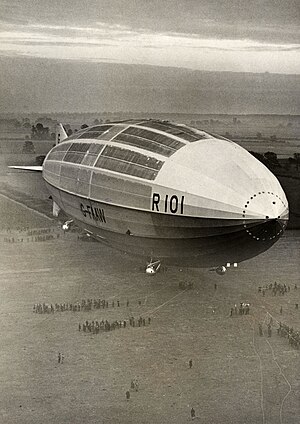R101
| R101 | |
|---|---|
 |
|
| Role | Experimental airship |
| Manufacturer | Royal Airship Works |
| Designer | V.C. Richmond |
| First flight | 14 October 1929 |
| Number built | 1 |
| Program cost | £711,595 |
R101 was one of a pair of British rigid airships completed in 1929 as part of a British government programme to develop civil airships capable of service on long-distance routes within the British Empire. It was designed and built by an Air Ministry-appointed team and was effectively in competition with the government-funded but privately designed and built R100. When built it was the world's largest flying craft at 731 ft (223 m) in length, and it was not surpassed by another hydrogen-filled rigid airship until the Hindenburg flew seven years later.
After some trial flights, and subsequent modifications to increase lifting capacity which included lengthening the airship by 46 ft (14 m), it crashed on 5 October 1930 in France during its maiden overseas voyage, killing 48 of the 54 people on board. Among the deceased passengers were Lord Thomson, the Air Minister who had initiated the programme, senior government officials, and almost all the dirigible's designers from the Royal Airship Works. The crash of R101 effectively ended British airship development, and was one of the worst airship accidents of the 1930s. The loss of life was more than the 36 killed in the highly public Hindenburg disaster of 1937, though fewer than the 52 killed in the French military Dixmude in 1923, and 73 killed when the USS Akron broke up over the sea in 1933.
R101 was built as part of a British government initiative to develop airships to provide passenger and mail transport from Britain to the most distant parts of the British Empire, including India, Australia and Canada, since these distances were too great for heavier-than-air aircraft of the period. The Burney Scheme of 1922 had proposed a civil airship development programme to be carried out by a specially established subsidiary of Vickers with the support of the British government, but when the General Election of 1923 brought Ramsay MacDonald’s Labour administration to power the new Air Minister, Lord Thomson, formulated the Imperial Airship Scheme in its place. This called for the building of two experimental airships: one, R101, to be designed and constructed under direction of the Air Ministry, and the other, R100, to be built by a Vickers subsidiary, the Airship Guarantee Company, under a fixed price contract. This led to the nicknames the "Socialist Airship" and the "Capitalist Airship".
...
Wikipedia
